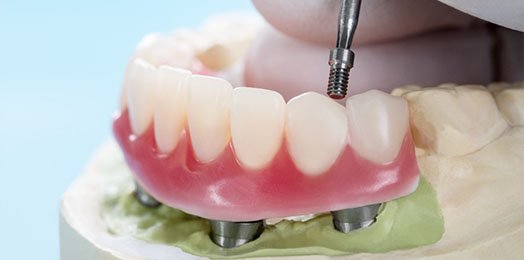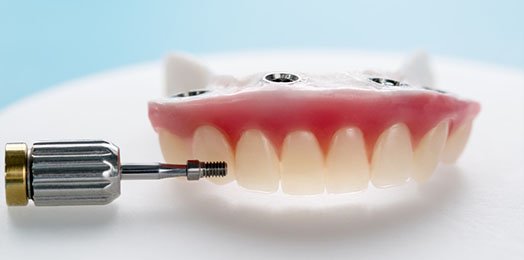Dental Implants
The Most Effective Dental Restoration

Dental Implants Melbourne CBD
Has your dentist told you that you would need dental implants?
Are you overwhelmed of all of the choices?
Well, maybe this can make choosing a little easier.
Read on to learn about the different types of dental implants available and your implant options.
Types of Dental Implants in Melbourne CBD

Single Implant
Dental implants are artificial tooth roots usually made from titanium that are surgically placed into your jawbone.
Using this implant, your Melbourne CBD dentist can attach an artificial tooth in place.
Mini Dental Implants
These are toothpick-sized implants that are extremely narrow. Their primary use is to stabilise a lower denture.
They are less innovative than the others, but still an acceptable option for you to look into.


All-On-4 Dental Implants
All-On-4 Dental Implants are used as an alternative for placing a full set of top or bottom restorations.
Four dental implants are surgically placed into the jawbone; this does away with the need for bone grafting.
A temporary set of replacement teeth can be installed the same day.
The Dental Implantation Procedure
Placing the Dental Implant
During dental implant surgery, your Melbourne CBD dentist makes a cut to open your gum and expose the bone. Holes are drilled into the bone where the dental implant metal post will be placed. Since the post will serve as the tooth root, it’s implanted deep into the bone. At this point, you’ll still have a gap where your tooth is missing. Usually, a type of partial, temporary denture can be placed for appearance. You can remove this denture for cleaning and while you sleep.
Waiting for Bone Growth
Once the metal implant post is placed in your jawbone, osseointegration (oss-ee-oh-in-tuh-GRAY-shun) begins. During this process, the jawbone grows into and unites with the surface of the dental implant. This process, which can take up to six months, helps provide a solid base for your new artificial tooth — just as roots do for your natural teeth.
Placing the Abutment
When osseointegration is complete, you may need additional surgery to place the abutment — the piece where the crown will eventually attach. This minor surgery is typically done with local anaesthesia in an outpatient setting.
To place the abutment:
- Your Melbourne CBD dentist reopens your gum to expose the dental implant
- The abutment is attached to the dental implant
- The gum tissue is then closed around, but not over, the abutment
In many cases, the abutment is attached to the dental implant metal post when the post is implanted. That means you won’t need an extra surgical step.
Because the abutment juts past the gumline, however, it’s visible when you open your mouth — and it will be that way until your Melbourne CBD dentist completes the tooth prosthesis.
Some people don’t like that appearance and prefer to have the abutment placed in a separate procedure.
Choosing your New Artificial Teeth
After the abutment is placed, your gums must heal for one or two weeks before the artificial tooth can be attached. Once the gums heal, you’ll have more impressions made of your mouth and remaining teeth.
These impressions are used to make the crown — your realistic-looking artificial tooth. The crown can’t be placed until your jawbone is strong enough to support the use of the new tooth.
You and your dental professional can choose from two main types of artificial teeth:
A removable implant prosthesis
This type is similar to a conventional removable denture. It contains artificial white teeth surrounded by pink plastic gum. It’s mounted on a metal frame that’s attached to the implant abutment, and it snaps securely into place.
It can be easily removed for repair or daily cleaning. It’s often a good choice when several teeth in the lower jaw are replaced, mainly because it’s more affordable than multiple individual dental implants and yet more secure than a traditional denture.
A fixed implant prosthesis
In this type, an artificial tooth is permanently screwed or cemented onto an individual implant abutment. You can’t remove the tooth for cleaning or during sleep.
If affordability isn’t a concern, you can opt to replace several missing teeth this way. Each crown is attached to its own dental implant.

After Surgery
Whether you have dental implant surgery in one stage or multiple stages, you may experience some of the typical discomforts associated with any type of dental surgery, such as:
- Swelling of your gums and face
- Bruising of your skin and gums
- Pain at the implant site
- Minor bleeding
If swelling, discomfort or any other problem gets worse in the days after surgery, contact your Melbourne CBD dentist. You may need pain medications or antibiotics.
After each stage of surgery, you may need to eat soft foods while the surgical site heals — as long as 10 to 14 days.
Dental Implants in Melbourne CBD
Finding your perfect smile shouldn’t be difficult.
There are many different types of dental implants out there for you to choose from.
Your Melbourne CBD dentist at Art De Dente will work closely with you to find the perfect match for you.
Claim your FREE Dental Implants Consultation on (03) 9642 8955 or request an appointment online.
We are located at Level 17, 190 Queen Street in Melbourne CBD.

Frequently Asked Questions
How do dental implants work?
Dental implants replace the whole structure of your missing tooth: that is, its visible portion as well as the supportive root.
Am I a candidate for dental implants?
What are alternative options to dental implants?
Alternative options for dental implants include the traditional crown and bridge or non-implant retained dentures and partials.
